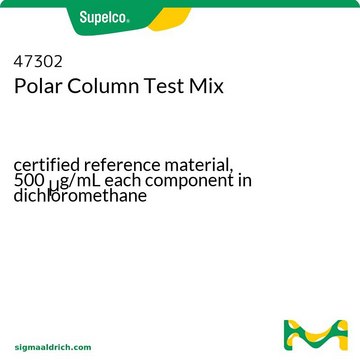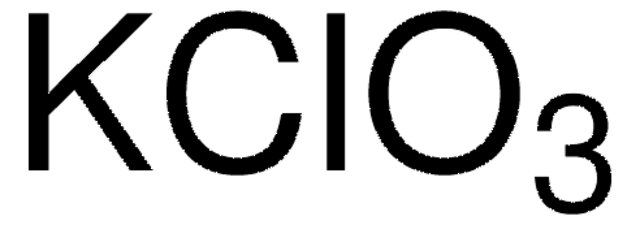All Photos(2)
About This Item
Linear Formula:
NaClO3
CAS Number:
Molecular Weight:
106.44
EC Number:
MDL number:
UNSPSC Code:
12352302
PubChem Substance ID:
NACRES:
NA.55
Assay:
≥99%
form:
crystals or chunks
Recommended Products
Quality Level
product line
ReagentPlus®
Assay
≥99%
form
crystals or chunks
mp
248-261 °C (lit.)
SMILES string
[Na+].[O-]Cl(=O)=O
InChI
1S/ClHO3.Na/c2-1(3)4;/h(H,2,3,4);/q;+1/p-1
InChI key
YZHUMGUJCQRKBT-UHFFFAOYSA-M
Looking for similar products? Visit Product Comparison Guide
Related Categories
General description
Sodium chlorate exhibits piezoelectric effect. On heating, it decomposes to give sodium chloride and sodium perchlorate. It can be synthesized in laboratory by reacting chlorine gas with a hot aqueous solution of sodium hydroxide or sodium carbonate.
Application
Sodium chlorate (NaClO3) has been used in the preparation of aromatic amino acid and σ32 peptide (from Drosophila melanogaster) samples for NMR analysis.
It may be used in the synthesis of chlorine dioxide and sodium perchlorate. It may also be employed as a sulfation inhibitor in the culture medium of HepG2 cells ((human hepatocellular liver carcinoma cells).
It may be used in the synthesis of chlorine dioxide and sodium perchlorate. It may also be employed as a sulfation inhibitor in the culture medium of HepG2 cells ((human hepatocellular liver carcinoma cells).
Biochem/physiol Actions
sulfation biosynthesis inhibitor
Legal Information
ReagentPlus is a registered trademark of Merck KGaA, Darmstadt, Germany
Signal Word
Danger
Hazard Statements
Precautionary Statements
Hazard Classifications
Acute Tox. 4 Oral - Aquatic Chronic 2 - Ox. Sol. 1
Storage Class Code
5.1A - Strongly oxidizing hazardous materials
WGK
WGK 2
Flash Point(F)
Not applicable
Flash Point(C)
Not applicable
Choose from one of the most recent versions:
Already Own This Product?
Find documentation for the products that you have recently purchased in the Document Library.
Customers Also Viewed
Jung Ho Lee et al.
The journal of physical chemistry. B, 117(20), 6069-6081 (2013-04-09)
NMR is an extremely powerful, yet insensitive technique. Many available nuclear polarization methods that address sensitivity are not directly applicable to low-concentration biomolecules in liquids and are often too invasive. Photochemically induced dynamic nuclear polarization (photo-CIDNP) is no exception. It
Heidi Barth et al.
The Journal of biological chemistry, 278(42), 41003-41012 (2003-07-18)
The conservation of positively charged residues in the N terminus of the hepatitis C virus (HCV) envelope glycoprotein E2 suggests an interaction of the viral envelope with cell surface glycosaminoglycans. Using recombinant envelope glycoprotein E2 and virus-like particles as ligands
Eric Lee et al.
The Journal of emergency medicine, 44(2), 381-384 (2012-05-15)
Chlorate poisoning as a cause of methemoglobinemia is regarded in current literature to be resistant to treatment by methylene blue due to the oxidizing and denaturing properties of the chlorate anion, and often leads to severe renal and hematological complications
Juergen Burkhardt et al.
The New phytologist, 196(3), 774-787 (2012-09-19)
The recent visualization of stomatal nanoparticle uptake ended a 40-yr-old paradigm. Assuming clean, hydrophobic leaf surfaces, the paradigm considered stomatal liquid water transport to be impossible as a result of water surface tension. However, real leaves are not clean, and
Fei Wang et al.
Chemosphere, 89(8), 1009-1014 (2012-08-18)
Understanding the interaction of perfluorochemicals, persistent pollutants with known human health effects, with mineral compounds in surface water and groundwater environments is essential to determining their fate and transport. Kinetic experiments showed that adsorption equilibrium can be achieved within 48
Our team of scientists has experience in all areas of research including Life Science, Material Science, Chemical Synthesis, Chromatography, Analytical and many others.
Contact Technical Service












